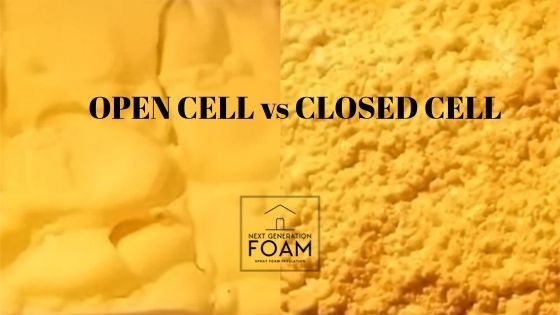Open Cell vs. Closed Cell Spray Foam Insulation
In the realm of insulation solutions, two titans stand tall: open cell and closed cell spray foam insulation. These remarkable options have revolutionized energy efficiency and comfort, but understanding their differences and similarities is the key to making the right choice for your property.
At Next Generation Foam, we're here to break down the intricacies of these insulation superheroes, so you can embark on your journey to a cozier, more efficient space fully informed.

The Common Ground: Insulating Power:
Both open cell and closed cell spray foam insulation share a common goal - to create an airtight seal that prevents unwanted air leakage and temperature fluctuations. This results in improved energy efficiency, reduced utility bills, and enhanced indoor comfort.
Cellular Structure: The Distinction:
The primary difference between these two types lies in their cellular structures. Open cell foam is softer and less dense, with interconnected air pockets. Closed cell foam, on the other hand, is denser and features closed, individual cells. This structural variation leads to divergent performance characteristics.
The Insulation Duo: Performance Unveiled:
- Insulation Efficiency:
- Open Cell: While it provides effective insulation, open cell foam's structure allows for air to pass through more easily.
- Closed Cell: Closed cell foam boasts a higher R-value per inch, offering superior insulation and a more substantial barrier against air infiltration.
- Air and Moisture Barrier:
- Open Cell: Its permeability to moisture makes it a better option for interior use, where vapor transmission is managed.
- Closed Cell: Its denser structure makes it an effective air and moisture barrier, suitable for exterior and subgrade applications.
- Soundproofing:
- Open Cell: Its soft, sound-absorbing properties make it an excellent choice for reducing noise transfer within the building.
- Closed Cell: While it does offer some sound-dampening qualities, open cell foam is more efficient in this aspect.
Environmental Impact: The Sustainability Factor:
Both open cell and closed cell foam can contribute to energy efficiency, thereby reducing carbon footprints. However, open cell foam generally requires fewer raw materials, making it a slightly more eco-friendly option.
Choosing Wisely: Your Property's Needs:
Deciding between open cell and closed cell spray foam insulation hinges on your property's specific requirements. If you're seeking a budget-friendly solution with remarkable sound absorption, open cell foam might be ideal. For exceptional insulation performance, vapor barrier capabilities, and added structural support, closed cell foam might be the answer.
Embark on the Insulation Odyssey: Consult with Us!
Ready to embark on your insulation journey? Reach out to Next Generation Foam, and let our experts guide you through the decision-making process. With our knowledge and your vision, we'll create a customized insulation plan that aligns perfectly with your property's needs.
The choice between open cell and closed cell spray foam insulation is yours, but you're not alone in making it. Connect with us today and let's explore the insulation options that will redefine your property's comfort and efficiency.
Let’s talk about your project
Fill in the form or call to set up a meeting at (715) 255-2632



